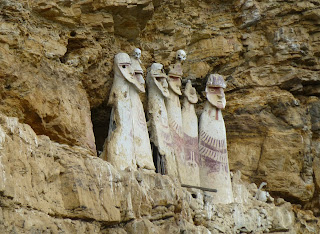The Chachapoyas empire came later, dating from around 800 AD up to the time of the Incas, and was further inland so involved a long and scenic drive to get there from the coast. At their funerary site of Karajía a number of sarcophagi sit on a high mountain ledge, their anthropomorphic mud and cane structures containing the bodies of the dead, some also with skulls atop their mud heads. Believed to date from around 1200 AD, there are clear signs that there were originally more of these or similar structures on the cliff ledges, including a number of human bones on the path at the base of the cliff. For me this was the best archaeological site of the trip.
At Revash we were able to get close-up views of other mountain-ledge tombs, constructed like large dolls houses but with human bones visible inside.

In the same area as Karajía we visited the large hilltop ruins of Kuélap. Surrounded by a high (up to 20m high) and thick wall it is often referred to as a fortress but it was more likely just a fortified town, as it contains the ruins of over 400 buildings, mostly circular, that appear to have been living quarters or perhaps storerooms. This was also a Chachapoyas site although a few later additions show that it was fnally taken over tby the Incas. Perhaps they were responsible for the skeletons unearthed there recently, more than 120 having been thrown into a pit at the site.

A little further on, just outside of the town of Leymebamba, was another great museum. It covers the history of the area but the clear highlight is a collection of some 200 mummies, found on rock ledges above the Lake of the Condors. It seems that nothing much is known about them except that they date from the late Inca period.
Amongst all these reminders of death, the twelve of us on the tour were dropping (ill, not dead!) like flies. Thankfully I only went down with a cold, although the mild temperature that signalled its arrival made a 2km uphill walk, at 2600m, one of the most difficult I have ever done. Others also got coughs and colds, fevers, dizzy spells, headaches from the altitude and the twisting mountain roads, and a vomiting and diarrhoea bug laid some low. Worst of all though came from a vicious dog that bit two of the group on the walk up to Revash. In one case the bite went through skin and flesh and into the muscle, and the poor guy needed anti-rabies injections once we got back to Lima.

I am in love with ancient civilizations! It is very interesting articles.
ReplyDelete